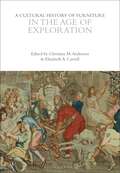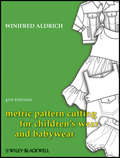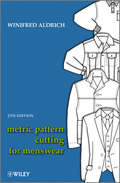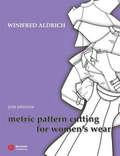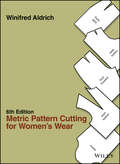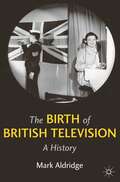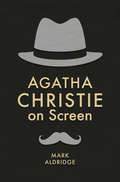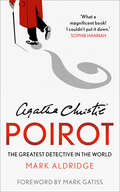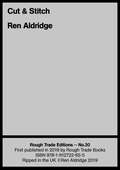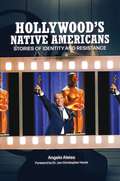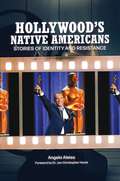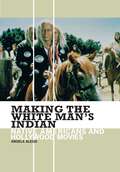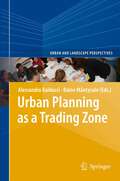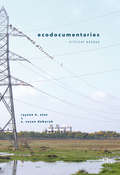- Table View
- List View
Reconstructing Ancient Linen Body Armor: Unraveling the Linothorax Mystery
by Gregory S. Aldrete Alicia Aldrete Scott M. BartellAlexander the Great led one of the most successful armies in history and conquered nearly the entirety of the known world while wearing armor made of cloth. How is that possible? In Reconstructing Ancient Linen Body Armor, Gregory S. Aldrete, Scott Bartell, and Alicia Aldrete provide the answer.An extensive multiyear project in experimental archaeology, this pioneering study presents a thorough investigation of the linothorax, linen armor worn by the Greeks, Macedonians, and other ancient Mediterranean warriors. Because the linothorax was made of cloth, no examples of it have survived. As a result, even though there are dozens of references to the linothorax in ancient literature and nearly a thousand images of it in ancient art, this linen armor remains relatively ignored and misunderstood by scholars. Combining traditional textual and archaeological analysis with hands-on reconstruction and experimentation, the authors unravel the mysteries surrounding the linothorax. They have collected and examined all of the literary, visual, historical, and archaeological evidence for the armor and detail their efforts to replicate the armor using materials and techniques that are as close as possible to those employed in antiquity. By reconstructing actual examples using authentic materials, the authors were able to scientifically assess the true qualities of linen armor for the first time in 1,500 years. The tests reveal that the linothorax provided surprisingly effective protection for ancient warriors, that it had several advantages over bronze armor, and that it even shared qualities with modern-day Kevlar.Previously featured in documentaries on the Discovery Channel and the Canadian History Channel, as well as in U.S. News and World Report, MSNBC Online, and other international venues, this groundbreaking work will be a landmark in the study of ancient warfare.
Reconstructing Ancient Linen Body Armor: Unraveling the Linothorax Mystery
by Gregory S. Aldrete Scott M. Bartell Alicia AldreteAlexander the Great led one of the most successful armies in history and conquered nearly the entirety of the known world while wearing armor made of cloth. How is that possible? In Reconstructing Ancient Linen Body Armor, Gregory S. Aldrete, Scott Bartell, and Alicia Aldrete provide the answer.An extensive multiyear project in experimental archaeology, this pioneering study presents a thorough investigation of the linothorax, linen armor worn by the Greeks, Macedonians, and other ancient Mediterranean warriors. Because the linothorax was made of cloth, no examples of it have survived. As a result, even though there are dozens of references to the linothorax in ancient literature and nearly a thousand images of it in ancient art, this linen armor remains relatively ignored and misunderstood by scholars. Combining traditional textual and archaeological analysis with hands-on reconstruction and experimentation, the authors unravel the mysteries surrounding the linothorax. They have collected and examined all of the literary, visual, historical, and archaeological evidence for the armor and detail their efforts to replicate the armor using materials and techniques that are as close as possible to those employed in antiquity. By reconstructing actual examples using authentic materials, the authors were able to scientifically assess the true qualities of linen armor for the first time in 1,500 years. The tests reveal that the linothorax provided surprisingly effective protection for ancient warriors, that it had several advantages over bronze armor, and that it even shared qualities with modern-day Kevlar.Previously featured in documentaries on the Discovery Channel and the Canadian History Channel, as well as in U.S. News and World Report, MSNBC Online, and other international venues, this groundbreaking work will be a landmark in the study of ancient warfare.
A Cultural History of Furniture in the Age of Exploration (The Cultural Histories Series)
by Professor Megan AldrichThe 16th and 17th centuries in Europe witnessed a significant paradigm shift. Rooted in medieval beliefs and preoccupations, the exploration so characteristic of the period stemmed from religious motives but came to be propelled by commerce and curiosity as Europeans increasingly engaged with the rest of the world. Interiors in both public and private spaces changed to reflect these cultural encounters and, with them, the furniture with which they were populated. Visually, furniture of this period displayed new designs, forms and materials. In its uses, it also mirrored developments in science, technology, government and social relationships as prints became more widely distributed, the Wunderkammer developed and there was religious strife and resistance to absolute monarchical rule.Drawing upon a wealth of visual and textual sources, this volume presents essays that examine key characteristics of the furniture of the period on the themes of Design and Motifs; Makers, Making, and Materials; Types and Uses; The Domestic Setting; The Public Setting; Exhibition and Display; Furniture and Architecture; Visual Representations; and Verbal Representations.
A Cultural History of Furniture in the Age of Exploration (The Cultural Histories Series)
by Professor Megan AldrichThe 16th and 17th centuries in Europe witnessed a significant paradigm shift. Rooted in medieval beliefs and preoccupations, the exploration so characteristic of the period stemmed from religious motives but came to be propelled by commerce and curiosity as Europeans increasingly engaged with the rest of the world. Interiors in both public and private spaces changed to reflect these cultural encounters and, with them, the furniture with which they were populated. Visually, furniture of this period displayed new designs, forms and materials. In its uses, it also mirrored developments in science, technology, government and social relationships as prints became more widely distributed, the Wunderkammer developed and there was religious strife and resistance to absolute monarchical rule.Drawing upon a wealth of visual and textual sources, this volume presents essays that examine key characteristics of the furniture of the period on the themes of Design and Motifs; Makers, Making, and Materials; Types and Uses; The Domestic Setting; The Public Setting; Exhibition and Display; Furniture and Architecture; Visual Representations; and Verbal Representations.
Vestiges of Colonial Empire in France
by R. AldrichThis book offers the first comprehensive study of 'sites of memory' in France connected to the history of French imperialism and colonialism, and the ways that the French have remembered or forgotten their colonial past. Through a study of monuments, memorials, museum collections and other 'sites of memory' in France connected with France's overseas empire this book analyzes the way in which French authorities marked the Paris and provincial landscapes with these reminders of France's colonial 'mission' during the period of imperial expansion, and the fate of these sites in the post-colonial period and what that evolution reveals about French memory and amnesia of the colonial epoch.
Fabrics and Pattern Cutting: Fabric, Form And Flat Pattern Cutting
by Winifred AldrichGetting the right cut for the right fabric is the key to good design. One of the most challenging aspects of a fashion designer’s training is learning how to crate patterns that utilize the characteristics of fabrics. With an ever expanding range available, an understanding of the relationship between fabric, form and pattern shape is now the most important skill a designer has to acquire. Winifred Aldrich, a leading pattern cutting authority, explores how a garment’s shape is created and discusses the factors that need to be considered when creating patterns and offers you a practical method for solving problems. No other pattern cutting book considers the effects of individual fabrics and its approach is based on the appraisal of the fabric and body shape. Fabrics and Patterns Cutting is the revised and simplified edition of Fabric, Form and Flat Pattern Cutting. It is fully illustrated and makes use of numerous practical examples. It also takes into account important new developments in fabric – new fabrics, new methods of fabric construction and new fabric finishes. Free block patterns are available online for readers to print out for use in their classes.
Metric Pattern Cutting for Children's Wear and Babywear
by Winifred AldrichThis fourth edition of Metric Pattern Cutting for Children’s Wear and Babywear remains the standard text book but has three majorimprovements. First, the sections have been re-organised to reflect changes in producing and marketing children’s clothes. Today’s popularity of easy-fitting styles and knitted fabrics means that basic ‘flat’ pattern cutting is used to construct the majority of children’s wear and babywear and this type of cutting is therefore emphasised in this new edition. Shaped blocks and garments, cut to fit the body form, are still included, and are placed in chapters covering some school uniform garments or more expensive fashion or formal clothes. The book now clearly separates the sections useful to student beginners (Parts One, Two and Three), and also offers more advanced or specialist sections for students who wish to pursue a career in children’s wear or for designers working in the different manufacturing sectors of the trade. The second change in this fourth edition is the introduction of colour coding to the sections; this makes it easier to identify specific processes in the book and enhances the illustrations. Finally, the size charts have been revised to reflect the changes in body sizing. The clear division of the boys’ and girls’ measurements in the charts has been in response to the way clothes are marketed and to co-ordinate with European size charts. ‘Plus’ charts for heavier children have also been added.
Metric Pattern Cutting for Menswear: Including Unisex Casual Clothes
by Winifred AldrichSince the first edition was published in 1980, Metric Pattern Cutting for Menswear has become established as the standard work on this subject and has proved invaluable as both a textbook for students and a reference source for the practising designer. In this fifth edition, the chapter on computer aided design now has full colour illustrations and reflects the growing importance of CAD to the industry and as a part of fashion and design courses. The rest of the book has been updated where necessary: in particular, new blocks for tailored shirts, new details on how to adapt men’s blocks for women’s wear, and a revision of sizing and labelling information. Colour is now used to differentiate the main groups of patterns and with its tried and tested layout with clear text and diagrams, Metric Pattern Cutting for Menswear is an essential purchase for students of fashion and design.
Metric Pattern Cutting for Women's Wear
by Winifred AldrichMetric Pattern Cutting for Women’s Wear, first published in 1975, provides a straightforward introductory book for students beginning courses in flat pattern cutting. This fifth edition continues to offer an introduction to the principles of pattern cutting, with a range of good basic blocks and examples of their application to garments. New for this edition is the inclusion of colour to help students recognize the different sections of the book and to enhance the garment illustrations? Colour illustrations also offer a new dimension to the updated material on computer-aided design and the CAD chapter now provides students with a clear guide to the technology. The size charts have been revised to reflect the changes in body sizing, the co-ordination with European size charts and to the way that clothes are now marketed to different sectors. The great expansion of casual wear has led to the growth of 'flat cutting' with no darting, and the section devoted to this type of cutting has been further expanded. This best-selling textbook with its tried-and-tested presentation of authoritative text and clear diagrams remains the essential purchase for students of fashion and design.
Metric Pattern Cutting for Women's Wear
by Winifred AldrichMetric Pattern Cutting for Women's Wear provides a straightforward introduction to the principles of form pattern cutting for garments to fit the body shape, and flat pattern cutting for casual garments and jersey wear. This sixth edition remains true to the original concept: it offers a range of good basic blocks, an introduction to the basic principles of pattern cutting and examples of their application into garments. Fully revised and updated to include a brand new and improved layout, up-to-date skirt and trouser blocks that reflect the changes in body sizing, along with updates to the computer-aided design section and certain blocks, illustrations and diagrams. This best-selling textbook still remains the essential purchase for students and beginners looking to understand pattern cutting and building confidence to develop their own pattern cutting style.
The Birth of British Television: A History
by M. AldridgeWhen the BBC launched the world's first regular, high-definition television service on 2 November, 1936 it was the culmination of decades of technological innovations. More than this, however, the service meant that the principle of television had finally found its place. The Birth of British Television – A History traces the early history and development of television, from the experiments of amateurs to the institutionalised developments that led to the world's first regular, high definition television service. Author Mark Aldridge provides a clear, in-depth and accessible introduction for those either exploring the period for the first time or seeking new insights into the beginnings of the industry. In tracing the origins and development of television, Aldridge focuses on a number of important factors including the attitude of the press towards early television and examines the way that expectations of television changed over time prior to its official launch. Utilising new research, this illuminating study examines how the aims for a new television service developed, and the extent to which content and technology were linked. The Birth of British Television approaches this formative period from several perspectives, from private individuals to the BBC and government, while also examining the broader opinions at the time towards the new medium through press reports and feedback from the general public. Also included is an assessment of early programming, which helps to offer a new and profound evaluation of the development of early television. Mark Aldridge is a Lecturer in Film and TV Studies at Southampton Solent University, UK. He specialises in British television and both film and television history. His previous publications include T is for Television (2008), an analysis of the work of Russell T. Davies, co-written with Andy Murray.
Agatha Christie on Screen (Crime Files)
by Mark AldridgeThis book is a comprehensive exploration of 90 years of film and television adaptations of the world’s best-selling novelist’s work. Drawing on extensive archival material, it offers new information regarding both the well-known and forgotten screen adaptations of Agatha Christie’s stories, including unmade and rare adaptations, some of which have been unseen for more than half a century. This history offers intriguing insights into the discussions and debates that surrounded many of these screen projects – something that is brought to life through previously unpublished correspondence from Christie herself and a new wide-ranging interview with her grandson, Mathew Prichard. Agatha Christie on Screen takes the reader on a journey from little known silent film adaptations, through to famous screen productions including 1974’s Murder on the Orient Express, as well as the television series of the Poirot and Miss Marple stories and, most recently, the BBC’s acclaimed version of And Then There Were None.
Agatha Christie’s Poirot: The Greatest Detective In The World
by Mark AldridgeFrom the very first book publication in 1920 to the film release of Death on the Nile in December 2020, this investigation into Agatha Christie’s Hercule Poirot celebrates a century of probably the world’s favourite fictional detective.
Cut & Stitch (Rough Trade Edition)
by Ren AldridgeCut & Stitch collects together some of the in-betweens and afterthoughts of Petrol Girls’ latest record of the same name, from the perspective of lead vocalist and lyricist, Ren Aldridge. In a similar process to speaking between songs on stage, Aldridge develops and contextualises the ideas and lyrics on the record, writing in and out of them, and making links between them. Through a series of mini-essays, she explores cutting and stitching as a way of thinking about topics such as community, the environment, building solidarity, resisting perfectionism, emotional labour, gender and craft.
Risk: The Concepts of Risk, Danger and Chance (PDF)
by Ben AleInvestments, global warming and crossing the road – risk is a factor embedded in our everyday lives but do we really understand what it means, how it is quantified and how decisions are made? In six chapters Ben Ale explains the concepts, methods and procedures for risk analysis and in doing so provides an introductory understanding of risk perception, assessment and management. Aided by over seventy illustrations, the author casts light on the often overlooked basics of this fascinating field, making this an essential text for students at undergraduate and postgraduate level as well as policy and decision-making professionals. Developed from the Safety Science or Risk Science course taught at Delft University, this highly respected author has a lifetime of knowledge and experience in the study of risk.
Hollywood's Native Americans: Stories of Identity and Resistance (Non-ser.)
by Angela AleissThis book highlights the contributions and careers of Native Americans who have carved impressive careers in Hollywood, from the silent film era of the early 1900s to the present, becoming advocates for their heritage.This book explores how the heritage and behind-the-scenes activities of Native American actors and filmmakers helped shape their own movie images. Native artists have impacted movies for more than a century, but until recently their presence had passed largely unrecognized. From the silent era to contemporary movies, this book features leading Native American actors whose voices have reached a broad audience and are part of the larger conversation about the exploitation of underrepresented people in Hollywood.Each chapter highlights Native actors in lead or supporting roles as well as filmmakers whose movies were financed and distributed by Hollywood studios. The text further explores how a "pan-Indian heritage" that applies to all tribes in terms of spirituality, historical trauma, and a version of ceremony and storytelling have shaped these performers' movie identities. It will appeal to a wide range of readers, including fans of Westerns, history buffs of American popular cinema, and students and scholars of Native American studies.
Hollywood's Native Americans: Stories of Identity and Resistance
by Angela AleissThis book highlights the contributions and careers of Native Americans who have carved impressive careers in Hollywood, from the silent film era of the early 1900s to the present, becoming advocates for their heritage.This book explores how the heritage and behind-the-scenes activities of Native American actors and filmmakers helped shape their own movie images. Native artists have impacted movies for more than a century, but until recently their presence had passed largely unrecognized. From the silent era to contemporary movies, this book features leading Native American actors whose voices have reached a broad audience and are part of the larger conversation about the exploitation of underrepresented people in Hollywood.Each chapter highlights Native actors in lead or supporting roles as well as filmmakers whose movies were financed and distributed by Hollywood studios. The text further explores how a "pan-Indian heritage" that applies to all tribes in terms of spirituality, historical trauma, and a version of ceremony and storytelling have shaped these performers' movie identities. It will appeal to a wide range of readers, including fans of Westerns, history buffs of American popular cinema, and students and scholars of Native American studies.
Making the White Man's Indian: Native Americans and Hollywood Movies (Non-ser.)
by Angela AleissThe image in Hollywood movies of savage Indians attacking white settlers represents only one side of a very complicated picture. In fact sympathetic portrayals of Native Americans stood alongside those of hostile Indians in the silent films of D. W. Griffith and Cecil B. DeMille, and flourished during the early 1930s with Hollywood's cycle of pro-Indian adventures. Decades later, the stereotype became even more complicated, as films depicted the savagery of whites (The Searchers) in contrast to the more peaceful Indian (Broken Arrow). By 1990 the release of Dances with Wolves appeared to have recycled the romantic and savage portrayals embedded in early cinema. In this new study, author Angela Aleiss traces the history of Native Americans on the silver screen, and breaks new ground by drawing on primary sources such as studio correspondence, script treatments, trade newspapers, industry censorship files, and filmmakers' interviews to reveal how and why Hollywood created its Indian characters. Behind-the-scenes anecdotes of filmmakers and Native Americans, as well as rare archival photographs, supplement the discussion, which often shows a stark contrast between depiction and reality.The book traces chronologically the development of the Native American's screen image while also examining many forgotten or lost Western films. Each chapter will feature black and white stills from the films discussed.
Frantz Fanon: Critical Perspectives
by Anthony C. AlessandriniFrantz Fanon was a fearless critic of colonialism and a key figure in Algeria's struggle for independence. Frantz Fanon: Critical Perspectives addresses Fanon's extraordinary, often contraversial writings, and examines the ways in which his work can shed light on contemporary issues in cultural politics. Embracing feminist theory, cultural studies and postcolonialism, Frantz Fanon: Critical Perspectives offers new directions for cultural and political thought in the postcolonial era.
Frantz Fanon: Critical Perspectives
by Anthony C. AlessandriniFrantz Fanon was a fearless critic of colonialism and a key figure in Algeria's struggle for independence. Frantz Fanon: Critical Perspectives addresses Fanon's extraordinary, often contraversial writings, and examines the ways in which his work can shed light on contemporary issues in cultural politics. Embracing feminist theory, cultural studies and postcolonialism, Frantz Fanon: Critical Perspectives offers new directions for cultural and political thought in the postcolonial era.
Urban Planning as a Trading Zone (Urban and Landscape Perspectives #13)
by Alessandro Balducci and Raine Mäntysalo'Trading zone' is a concept introduced by Peter Galison in his social scientific research on how scientists representing different sub-cultures and paradigms have been able to coordinate their interaction locally. In this book, Italian and Finnish planning researchers extend the use of the concept to different contexts of urban planning and management, where there is a need for new ideas and tools in managing the interaction of different stakeholders. The trading zone concept is approached as a tool in organizing local platforms and support systems for planning participation, knowledge production, decision making and local conflict management. In relation to the former theses of communicative planning theory that stress the ideals of consensus, mutual understanding and universal reason, the 'trading zone approach', outlined in this book, offers a different perspective. It focuses on the potentiality to coordinate locally the interaction of different stakeholders without requiring the deeper sharing of understandings, values and motives between them. Galison’s commentary comes in the form of the book’s final chapter.
Artificial Neural Networks and Machine Learning – ICANN 2016: 25th International Conference on Artificial Neural Networks, Barcelona, Spain, September 6-9, 2016, Proceedings, Part I (Lecture Notes in Computer Science #9886)
by Alessandro E.P. Villa Paolo Masulli Antonio Javier Pons RiveroThe two volume set, LNCS 9886 + 9887, constitutes the proceedings of the 25th International Conference on Artificial Neural Networks, ICANN 2016, held in Barcelona, Spain, in September 2016. The 121 full papers included in this volume were carefully reviewed and selected from 227 submissions. They were organized in topical sections named: from neurons to networks; networks and dynamics; higher nervous functions; neuronal hardware; learning foundations; deep learning; classifications and forecasting; and recognition and navigation. There are 47 short paper abstracts that are included in the back matter of the volume.
Artificial Neural Networks and Machine Learning – ICANN 2016: 25th International Conference on Artificial Neural Networks, Barcelona, Spain, September 6-9, 2016, Proceedings, Part II (Lecture Notes in Computer Science #9887)
by Alessandro E.P. Villa Paolo Masulli Antonio Javier Pons RiveroThe two volume set, LNCS 9886 + 9887, constitutes the proceedings of the 25th International Conference on Artificial Neural Networks, ICANN 2016, held in Barcelona, Spain, in September 2016. The 121 full papers included in this volume were carefully reviewed and selected from 227 submissions. They were organized in topical sections named: from neurons to networks; networks and dynamics; higher nervous functions; neuronal hardware; learning foundations; deep learning; classifications and forecasting; and recognition and navigation. There are 47 short paper abstracts that are included in the back matter of the volume.
How to Be a Design Academic: From Learning to Leading
by Alethea Blackler and Evonne MillerThis book is about how to be a design academic. In another words, how to manage the various challenges, requirements, and processes that come with both the everyday and extra-ordinary parts of an academic role in design fields (from architecture, urban design, interior design and landscape architecture, to fashion, industrial, interaction and graphic design). The book is organised in two parts – Part 1, Starting out and Part 2, Becoming a Leader. It includes real-life experiences of actual academics and offers a wide range of experiences of authors from early career researchers to full professors and heads of schools. It contains all aspects of academic life, including the highs and lows of teaching, research, leadership, and managing your working life and your career. This book is perfect for academics, aspiring academics, and research students in a wide range of design fields.
Ecodocumentaries: Critical Essays
by Rayson K. Alex S. Susan DeborahThis book features ten critical essays on ecodocumentaries written by eminent scholars from India, USA, Ireland, Finland and Turkey in the area of ecocinema studies. Situating social documentaries with explicit ecological form and content, the volume takes relational positions on political, cultural and conservational aspects of natures and cultures in various cultural contexts. Documentaries themed around issues such as electronic waste, animal rights, land ethics, pollution of river, land grabbing, development and exotic plants are some of the topics ecocritiqued in this volume.

